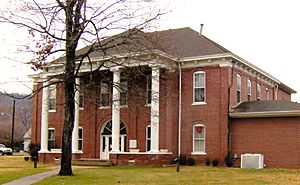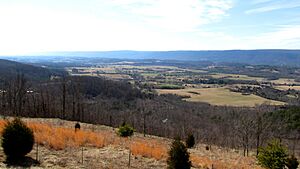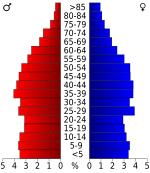Sequatchie County, Tennessee facts for kids
Quick facts for kids
Sequatchie County
|
|
|---|---|

Sequatchie County Courthouse in Dunlap
|
|

Location within the U.S. state of Tennessee
|
|
 Tennessee's location within the U.S. |
|
| Country | |
| State | |
| Founded | December 9, 1857 |
| Named for | Cherokee chief |
| Seat | Dunlap |
| Largest city | Dunlap |
| Area | |
| • Total | 266 sq mi (690 km2) |
| • Land | 266 sq mi (690 km2) |
| • Water | 0.2 sq mi (0.5 km2) 0.07%% |
| Population
(2020)
|
|
| • Total | 15,826 |
| • Density | 53/sq mi (20/km2) |
| Time zone | UTC−6 (Central) |
| • Summer (DST) | UTC−5 (CDT) |
| Congressional district | 4th |
Sequatchie County is a county in the state of Tennessee, United States. In 2020, about 15,826 people lived there. The main town and county center is Dunlap. Sequatchie County is part of the larger Chattanooga city area.
Contents
History of Sequatchie County
Sequatchie County was created in 1857. It was formed from parts of Marion County and Bledsoe County. The county was named after the Sequatchie Valley. This valley was named for a Cherokee chief. The Cherokee word sequachee means 'opossum' or 'he grins.'
People started moving to this area in the early 1800s. They were looking for good land to farm in the valley.
Sequatchie County During the Civil War
When the American Civil War began, people in Sequatchie County had different ideas about leaving the United States. On June 8, 1861, the county voted to join the Confederacy. The vote was 153 to 100.
In October 1863, a Confederate general named Joseph Wheeler led a raid into Sequatchie. His soldiers burned almost a thousand wagons. They also took many farm animals.
Mining History in Dunlap
In the late 1800s, a company called Douglas Coal and Coke mined a lot of coal near Dunlap. This company later became the Chattanooga Iron and Coal Corporation. They built 268 special ovens called beehive ovens. These ovens turned coal into coke, which is a type of fuel. Today, these ovens are part of a local park called the Dunlap Coke Ovens.
Geography of Sequatchie County
Sequatchie County covers about 266 square miles. Almost all of this area is land. Only a very small part is water.
The Sequatchie Valley
Sequatchie County is one of three counties in the Sequatchie Valley. This valley is long and narrow. It runs from northeast to southwest across the eastern part of the Cumberland Plateau. On the east side of the county, you can see the steep Walden Ridge. The Sequatchie River flows through the valley and passes through the county.
Two main roads meet in Dunlap. These are U.S. Route 127 and Tennessee State Route 111.
Even though Bledsoe and Marion counties (also in the Sequatchie Valley) are part of East Tennessee, Sequatchie County is grouped with Middle Tennessee.
Counties Near Sequatchie
Sequatchie County shares borders with several other counties:
- Van Buren County (north)
- Bledsoe County (northeast)
- Hamilton County (southeast)
- Marion County (southwest)
- Grundy County (west)
- Warren County (northwest)
Protected Natural Areas
Parts of these state parks and forests are in Sequatchie County:
- Justin P. Wilson Cumberland Trail State Park
- North Chickamauga Creek Gorge State Park
- Prentice Cooper State Forest
- Savage Gulf State Park
People of Sequatchie County
| Historical population | |||
|---|---|---|---|
| Census | Pop. | %± | |
| 1860 | 2,120 | — | |
| 1870 | 2,335 | 10.1% | |
| 1880 | 2,565 | 9.9% | |
| 1890 | 3,027 | 18.0% | |
| 1900 | 3,326 | 9.9% | |
| 1910 | 4,202 | 26.3% | |
| 1920 | 3,632 | −13.6% | |
| 1930 | 4,047 | 11.4% | |
| 1940 | 5,038 | 24.5% | |
| 1950 | 5,685 | 12.8% | |
| 1960 | 5,915 | 4.0% | |
| 1970 | 6,331 | 7.0% | |
| 1980 | 8,605 | 35.9% | |
| 1990 | 8,863 | 3.0% | |
| 2000 | 11,370 | 28.3% | |
| 2010 | 14,112 | 24.1% | |
| 2020 | 15,826 | 12.1% | |
| U.S. Decennial Census 1790-1960 1900-1990 1990-2000 2010-2014 Its county seat is Dunlap. |
|||
2020 Census Information
In 2020, there were 15,826 people living in Sequatchie County. There were 5,528 households and 4,192 families.
| Race | Number | Percentage |
|---|---|---|
| White (not Hispanic) | 14,409 | 91.05% |
| Black or African American (not Hispanic) | 72 | 0.45% |
| Native American | 49 | 0.31% |
| Asian | 65 | 0.41% |
| Pacific Islander | 4 | 0.03% |
| Other/Mixed | 606 | 3.83% |
| Hispanic or Latino | 621 | 3.92% |
2010 Census Information
In 2010, there were 14,112 people living in the county. The population density was about 43 people per square mile. Most people (98.66%) were White.
There were 4,463 households. About 33% of these had children under 18. Most households (58.8%) were married couples. About 22.4% of households were single people.
The average age in the county was 37 years old. About 24.6% of the people were under 18. About 12.3% were 65 or older.
The average income for a household was $30,959. For a family, it was $36,435. About 16.5% of the population lived below the poverty line. This included 21.5% of children under 18.
Education in Sequatchie County
Sequatchie County has one school system. It is located in Dunlap. A superintendent and an elected school board manage the schools.
The Sequatchie County school system has three schools:
- Griffith Elementary School (for grades K–4)
- Sequatchie County Middle School (for grades 5–8)
- Sequatchie County High School (for grades 9–12)
Fun Things to Do in Sequatchie County
Sequatchie County is known as "The Hang Gliding Capital of the East." This is because of a group called the Tennessee Tree Toppers. They have a hang gliding ramp at Henson's Gap. This spot has good wind conditions. Hang gliders can fly for a long time from here. They can even fly into parts of Georgia and Alabama.
Henson's Gap hosts many hang gliding competitions. It is a popular place for hang gliding fans from all over the world.
Towns and Communities
City
- Dunlap (the county seat)
Census-Designated Place
Small Communities (Unincorporated)
These are smaller places that are not officially cities or towns:
- Brush Creek
- Cagle
- Lewis Chapel
Media and News
Many news and media groups serve Sequatchie County. These reach about one million people in four states: Tennessee, Alabama, Georgia, and North Carolina.
Newspapers
- The Dunlap Tribune: This newspaper focuses on local events, sports, and people in Dunlap and Sequatchie County.
Radio Stations
Sequatchie County is part of the Chattanooga radio market. These radio stations are licensed to cities in Sequatchie County:
- AM Radio
- WSDQ 1190 AM – Plays Country music (Licensed to Dunlap)
- FM Radio
- W227DM 93.3 - Country Roads 93.3 WSDQ (This is an FM translator for WSDQ-AM, licensed to Dunlap)
Famous People from Sequatchie County
- Phil Douglas (1890-1952), a Major League Baseball player. He played for the New York Giants when they won the 1921 World Series.
- Dakota Hudson (born 1994), a professional baseball player for the St. Louis Cardinals.
- James Standifer (1779-1837), a U.S. congressman.
- William Stone (1791-1853), a U.S. congressman.
Images for kids
See also
 In Spanish: Condado de Sequatchie para niños
In Spanish: Condado de Sequatchie para niños




